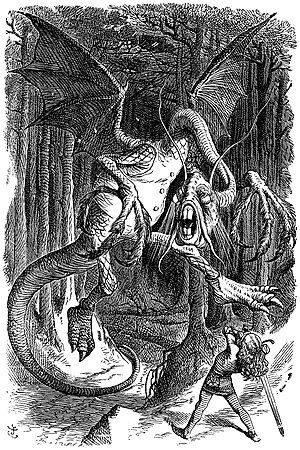Vorpal sword: Difference between revisions
Thumperward (talk | contribs) Undid revision 217549893 by 70.181.107.26 (talk) not a dumping ground |
|||
| Line 18: | Line 18: | ||
"Vorpal swords" exist fictionally in various works, especially in [[role-playing game]]s and [[video game]]s, where it is usually based on the Dungeons & Dragons concept. |
"Vorpal swords" exist fictionally in various works, especially in [[role-playing game]]s and [[video game]]s, where it is usually based on the Dungeons & Dragons concept. |
||
In Dungeons & Dragons, it first appeared in the original ''[[Dungeon Master's Guide]]'', listed as "sword, vorpal weapon". It could decapitate foes on a very high "to hit" die roll; in the earlier ''[[Greyhawk]] Supplement,'' the "Vorpal Blade" also functioned as a type of "holy sword", with special powers usable only by [[Paladin (Dungeons & Dragons)|paladins]]. In |
In Dungeons & Dragons, it first appeared in the original ''[[Dungeon Master's Guide]]'', listed as "sword, vorpal weapon". It could decapitate foes on a very high "to hit" die roll; in the earlier ''[[Greyhawk]] Supplement,'' the "Vorpal Blade" also functioned as a type of "holy sword", with special powers usable only by [[Paladin (Dungeons & Dragons)|paladins]]. In earlier incarnations, the vorpal sword decapitates any foe when the wielder scores a [[critical hit]]. Many [[MUD]]s (multi-user dungeons) and modern video games also incorporate the adjective into their weapon descriptions.{{Fact|date=May 2008}} The Vorpal Sword has been modified in the Dungeons and Dragons 4E, where if the maximum value is rolled on a damage dice, it may be rolled again and added to the damage total, plus a once-per-day ability that can add a large amount of damage to any attack. |
||
[[NetHack]] was the first computer game in which a vorpal sword appeared in a form which references the literature. The Vorpal Sword has a chance to behead an opponent. If the opponent is a Jabberwock, this chance becomes 100%. In the computer game [[Moria]] the Vorpal rabbit is an uncustomarily tenacious, brutal, swift and prolific rodent, in a nod both to the Jabberwock and to the [[Rabbit of Caerbannog]] from [[Monty Python and the Holy Grail]]. |
[[NetHack]] was the first computer game in which a vorpal sword appeared in a form which references the literature. The Vorpal Sword has a chance to behead an opponent. If the opponent is a Jabberwock, this chance becomes 100%. In the computer game [[Moria]] the Vorpal rabbit is an uncustomarily tenacious, brutal, swift and prolific rodent, in a nod both to the Jabberwock and to the [[Rabbit of Caerbannog]] from [[Monty Python and the Holy Grail]]. |
||
Revision as of 15:55, 11 June 2008

Vorpal sword is a phrase used by Lewis Carroll in his nonsense poem "Jabberwocky". It appears twice in the poem, which describes a young boy's quest to slay a monster called the Jabberwock: "He took his vorpal sword in hand", and later,
- One, two! One, two! And through and through
- The vorpal blade went snicker-snack!
- He left it dead, and with its head
- He went galumphing back.
As with much of the rest of the poem's vocabulary, the reader to guess at the meaning of "vorpal" from context. It is commonly assumed to mean "deadly" or "sharp"[citation needed], words often used to describe swords, but some readers have imagined other properties the word could describe. Alexander L. Taylor points out in his Carroll biography The White Knight that "vorpal" can be formed by taking letters alternately from "verbal" and "gospel".[1] The designers of the Dungeons & Dragons role-playing game take "vorpal" to mean capable of decapitation, specifically through magical means. This definition is of course a reference to the boy's decapitation of the Jabberwock.
Carroll himself once wrote, "I am afraid I can't explain 'vorpal blade' for you—nor yet 'tulgey wood.'"[1]
In popular culture
"Vorpal swords" exist fictionally in various works, especially in role-playing games and video games, where it is usually based on the Dungeons & Dragons concept.
In Dungeons & Dragons, it first appeared in the original Dungeon Master's Guide, listed as "sword, vorpal weapon". It could decapitate foes on a very high "to hit" die roll; in the earlier Greyhawk Supplement, the "Vorpal Blade" also functioned as a type of "holy sword", with special powers usable only by paladins. In earlier incarnations, the vorpal sword decapitates any foe when the wielder scores a critical hit. Many MUDs (multi-user dungeons) and modern video games also incorporate the adjective into their weapon descriptions.[citation needed] The Vorpal Sword has been modified in the Dungeons and Dragons 4E, where if the maximum value is rolled on a damage dice, it may be rolled again and added to the damage total, plus a once-per-day ability that can add a large amount of damage to any attack.
NetHack was the first computer game in which a vorpal sword appeared in a form which references the literature. The Vorpal Sword has a chance to behead an opponent. If the opponent is a Jabberwock, this chance becomes 100%. In the computer game Moria the Vorpal rabbit is an uncustomarily tenacious, brutal, swift and prolific rodent, in a nod both to the Jabberwock and to the Rabbit of Caerbannog from Monty Python and the Holy Grail.
The Vorpal Sword makes two appearances in Roger Zelazny's Chronicles of Amber series. In both instances, the ability to easily sever body parts was in evidence.
An extinct bird species from the Hawaiian Islands, the Giant ʻAmakihi, was assigned the Latin name Hemignathus vorpalis (literally "Vorpal ʻAmakihi") because of its "long, scimitar-like maxillary rostrum".[2]
See also
References
- ^ a b Gardner, Martin, ed. (1971). The Annotated Alice. New York: The World Publishing Company. pp. 195–196.
{{cite book}}:|first=has generic name (help); Unknown parameter|origdate=ignored (|orig-date=suggested) (help)CS1 maint: multiple names: authors list (link) - ^ James, Helen F. (2003). "A giant new species of Nukupuu (Fringillidae: Drepanidini: Hemignathus) from the island of Hawaii". The Auk 120: 970–981.
{{cite web}}: Unknown parameter|coauthors=ignored (|author=suggested) (help)
